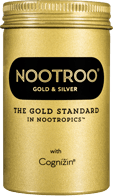What is brain plasticity? The process of how your brain changes based on what happens to it. It includes memory, learning new skills, the process by which you recover from brain damage, and it is also how you adapt to changes in your body over time.
The video below is all about enhancing the plasticity of the brain and in it, the amazing Max Cynader discusses how certain receptors work and that when stimulated, can cause the brain to release another type of receptor, thereby increasing the brain’s plasticity. I highly recommend you watch all of the video, but the excerpt below deals directly with the area of the brain that the main ingredients in Nootroo are able to have an effect on.

In the image above, you can look at the green box, “it’s called an AMPA receptor…if you put more [stimulation] in, more comes out. In other words, if you give it a weak stimulus, it gives a weak response, if you give it a stronger stimulus, it gives you a stronger response. If you give it a really strong stimulus, it gives you a really strong response, it’s called linear…Look at the NR receptor, NMDA receptor it is also called (the orange box)…it is very interesting, it is a very undemocratic receptor. It hates weak inputs, you give it a weak input, not only does it not respond, but it actually goes negative. If you give it a slightly stronger input, ehh, its still not very interested, if you give it a strong input, it goes crazy. And when it goes crazy, what it does is activates all of this machinery down here (red box below the NMDA receptor), and the effect of that machinery is to put in more of these ordinary boring receptors (green ones). So what that means is, if you can tickle the fancy of this NMDA receptor, you will put in more of these ordinary AMPA receptors into the synapse, and then the synapse will become stronger. And that actually seems to be the core mechanism of memory, of strengthening connections between two neurons. Of how strong inputs and contiguity can result in a stronger synapse, and that’s actually how we actually think you remember today’s lecture.”
